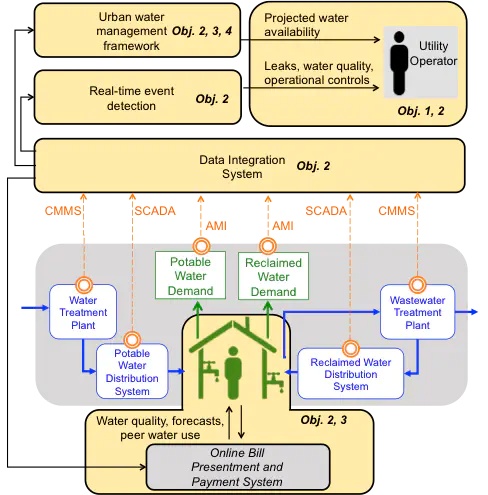Smart Water Management and Internet of Things

Urban areas face daunting environmental, socioecological, and infrastructure challenges. Information and communications technology (ICT) promises unprecedented capabilities to enable cities to improve the quality of life, efficiency of urban operations and services, and competitiveness, while maintaining sustainable use of resources. Ubiquitous sensing, information processing, and wireless networks are quickly becoming embedded in the fabric of contemporary cities, and the Internet of Things (IoT) connects everyday objects and devices to network technologies. The proliferation of these technologies enables the advent of “Smart Cities” that utilize ICT, IoT, and big data analytics to address critical urban challenges.
Water supply and infrastructure are major areas of concern for American cities and grand challenges facing engineers. Urban areas are running out of clean reliable sources of water, and innovative solutions are needed for long-term planning [7]. The US drinking water infrastructure serves 315 million people and is in need of replacement, upgrading, and maintenance to continue to support projected population growth. The American Society of Civil Engineers rated drinking water infrastructure with a grade of D- in 2009 and D in 2013, while the American Water Works Association estimates the cost of repairing and expanding US drinking water infrastructure at over $1 trillion through 2035 or $1.7 trillion through 2050. Because of the lapse in infrastructure maintenance, 77 million people are served by more than 18,000 water systems with water quality violations (based on 2015 data), and 2.1 trillion gallons of water are lost annually due to aging and leaky pipes, broken water mains, and faulty meters.
A promising application for smart and connected communities is the use of ICT and IoT technologies to improve urban water supply management. The IoT can connect personal smart devices with faucets and pipelines that are embedded with sensors, actuators, and network connectivity to collect and report real-time information about water consumption, quality, and losses. A water-smart city can sustainably use and reuse water resources by adapting real-time operations and planning practices in response to ubiquitous sensor networks and disparate but interconnected and heterogeneous data streams. While a survey of the water industry shows that 33% of utilities are interested in real-time control and big data system analytics, water utilities have predominantly not harnessed these technologies, due to a number of challenges associated with managing and analyzing big data. Technological gaps, workforce challenges, and community disengagement undermine the alignment of critical municipal management priorities with the analysis and application of smart water data. Installing data analytics systems can worsen data deluge, which is a serious challenge for municipalities, utilities, and their constituencies. The ubiquity of different types of sensors and data collection mechanisms obscures the issues with frequency and asynchronicity of data collection, the types of data generated, and gaps in datasets. Utilities that have installed smart meter systems need support to make sense of and apply data for decision-making, and applications are lacking that would demonstrate that the use of smart systems will support long-term sustainability and urban planning goals. The next generation smart water system should provide the analysis to guide water resources sustainability, stand as a first line of defense for communities that suffer from water quality issues, and catalyze a culture of water conservation within communities.